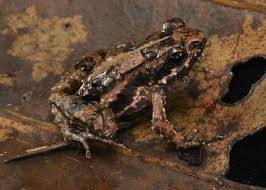In a significant stride for biodiversity, the Council for Scientific and Industrial Research-Forestry Research Institute of Ghana (CSIR-FORIG) has recently identified two potential new frog species within Ghana's rich ecosystems. This discovery not only underscores the nation's ecological wealth but also highlights the pressing need for conservation efforts to protect these and other threatened amphibian species.
The Discovery: Unveiling New Species
The CSIR-FORIG team, led by renowned herpetologist Dr. Caleb Ofori-Boateng, made this groundbreaking discovery during extensive field studies in the Atewa Range Forest Reserve. This area, already recognized for its unique biodiversity, has once again proven to be a reservoir of undiscovered species. The newly identified frogs exhibit distinct morphological and genetic characteristics, setting them apart from known species. Detailed scientific descriptions are underway to formally classify and name these amphibians.
Ghana's Amphibian Diversity: A Treasure Trove
Ghana is home to a remarkable array of amphibian species, with at least 25 currently listed as threatened. The country's diverse habitats, ranging from lush rainforests to savannahs, provide ideal conditions for a variety of frog species. However, habitat loss, pollution, and climate change have increasingly threatened these populations. The discovery of new species amidst these challenges emphasizes the resilience of nature and the importance of preserving these habitats.
Conservation Challenges: Threats to Amphibian Survival
Despite the rich biodiversity, Ghana's amphibians face numerous threats:
Habitat Destruction: Over 90% of West Africa's rainforests have been destroyed, primarily due to logging, mining, and agricultural expansion. This large-scale deforestation has led to the loss of critical habitats for many frog species. The Sui River Forest Reserve, for instance, has suffered extensive degradation from logging and illegal farming, endangering species like the critically endangered giant squeaker frog (Arthroleptis krokosua).
Pollution: The use of agrochemicals and improper waste disposal have led to the contamination of water bodies, adversely affecting aquatic life, including amphibians.
Climate Change: Shifts in temperature and precipitation patterns can alter breeding cycles and habitats, posing additional challenges to frog populations.
Invasive Species: Non-native plants, such as the highly flammable Devil Weed (Chromolaena odorata), thrive in disturbed areas, preventing the regeneration of native rainforest trees and altering the natural habitat essential for many frog species.
Conservation Efforts: Protecting Ghana's Frogs
Recognizing these challenges, various organizations and initiatives have been established to conserve Ghana's amphibian diversity:
SAVE THE FROGS! Ghana: Founded in 2011, this organization is West Africa's first nonprofit dedicated exclusively to amphibian conservation. Their mission encompasses protecting amphibian populations and promoting a society that values nature and wildlife.
Herp Conservation Ghana: This group has been instrumental in establishing protected areas, such as the Onepone Endangered Species Refuge, to safeguard critical habitats of endangered species like the Togo slippery frog (Conraua derooi). Their efforts have led to the expansion of protected areas to encompass larger breeding populations, ensuring the survival of these threatened species.
Research and Advocacy: Scientists like Dr. Caleb Ofori-Boateng have been pivotal in discovering new species and advocating for their protection. Their research has not only expanded scientific knowledge but also informed conservation strategies and policy decisions. For example, the discovery of the Afia Birago puddle frog in the Atewa Range Forest has led to increased efforts to protect this critical habitat.
The Role of Local Communities: Partners in Conservation
Engaging local communities is crucial for the success of conservation initiatives. In many instances, community members serve as stewards of the land, possessing invaluable indigenous knowledge about local ecosystems. Collaborative efforts have led to:
Community Reserves: Establishing community-managed reserves empowers locals to protect and manage their natural resources, leading to sustainable conservation outcomes.
Educational Programs: Raising awareness about the ecological importance of frogs and the threats they face fosters a conservation ethic among community members, encouraging them to participate actively in preservation efforts.
Alternative Livelihoods: Providing sustainable economic alternatives reduces dependence on activities that harm habitats, such as logging and mining.
Policy Implications: Strengthening Legal Frameworks
Effective conservation requires robust legal protections and enforcement:
Protected Area Designation: Identifying and legally designating critical habitats as protected areas can shield them from destructive activities. The Atewa Range Forest, for instance, has been recognized as an Alliance for Zero Extinction site, highlighting its global importance and the need for stringent protection measures.
Environmental Regulations: Implementing and enforcing regulations on pollution, land use, and resource extraction can mitigate threats to amphibian habitats.
Research Support: Allocating funding and resources for scientific research enables the discovery of new species and the development of informed conservation strategies.
Global Significance: Ghana's Contribution to Biodiversity
The discovery of new frog species in Ghana has implications beyond national borders:
Biodiversity Hotspot: Ghana's unique ecosystems contribute significantly to global biodiversity. Protecting these habitats ensures the survival of species found nowhere else on Earth.
Climate Regulation: Healthy amphibian populations play a role in regulating ecosystems, which in turn influence global climate patterns.
Scientific Advancement:


